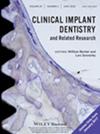Chairside vs Prefabricated Sealing Socket Abutments for Posterior Immediate Implants: A Randomized Clinical Trial
Abstract
Objectives
This randomized clinical trial aimed to compare changes in soft tissue height, probing depth, and buccal contour volume loss following immediate implant placement using either chairside composite or prefabricated zirconia Sealing Socket Abutments (SSAs) in the posterior region.
Materials and Methods
47 patients requiring posterior tooth extraction and immediate implant placement were randomly assigned to one of two groups: the composite Sealing Socket Abutment (CS) group (n = 24), receiving chairside-fabricated abutments, or the zirconia Sealing Socket Abutment (ZR) group (n = 23), receiving prefabricated abutments. Implants were placed immediately after extraction, using static computer-assisted implant surgery (sCAIS). Supra-Platform Tissue Height (SPTH) and total horizontal tissues (THT) were assessed using cone-beam computed tomography (CBCT) over a 3-month healing period. Implant survival, probing pocket depths (PPD), bleeding on probing (BOP) and plaque index (PI) were recorded clinically, while volumetric analysis was performed using digital impressions.
Results
SPTH remained stable from baseline to the 3-month follow-up, with a mean change of −0.17 mm in the CS group and −0.44 mm in the ZR group. These differences were not statistically significant (p > 0.05). THT exhibited significant horizontal shrinkage in both groups over the 3-month period. In the CS group, THT decreased by 1.00 mm, while the ZR group showed a reduction of 1.17 mm (p < 0.001). PPD increased in the CS group from 2.8 mm to 3.7 mm on the palatal/lingual aspect and from 2.5 mm to 3.2 mm on the buccal aspect (p = 0.026). In contrast, the ZR group showed a decrease from 3.1 mm to 2.7 mm palatally/lingually and remained stable buccally at 2.6 mm to 2.7 mm (p = 0.001). BOP in the CS group decreased from 42.3% to 7.7% (p = 0.009), while the ZR group maintained low BOP levels, decreasing slightly from 17.4% to 4.4% (p = 0.346).
Conclusions
Both approaches showed comparable outcomes. ZR abutments resulted in shallower probing depths, while CS abutments showed less volumetric shrinkage. SPTH remained stable in both groups.
Trial Registration
This trial was registered prior to patient enrollment at ClinicalTrials.gov identifier: NCT05748379

 求助内容:
求助内容: 应助结果提醒方式:
应助结果提醒方式:


